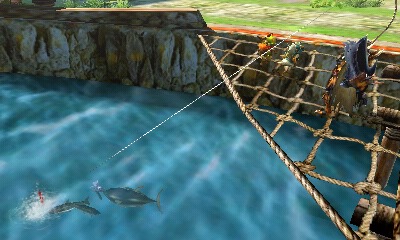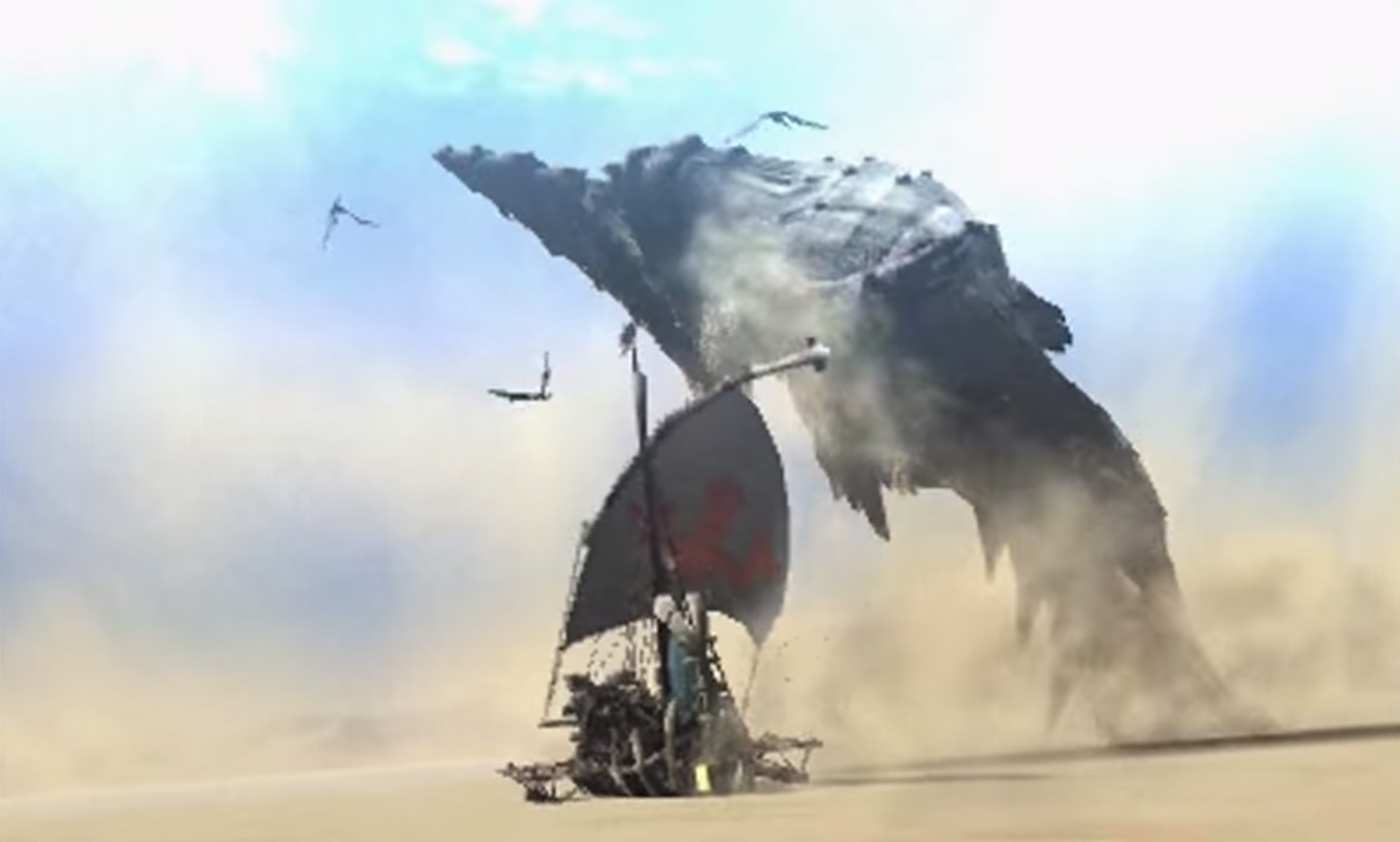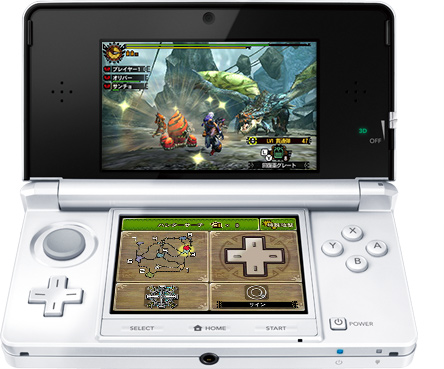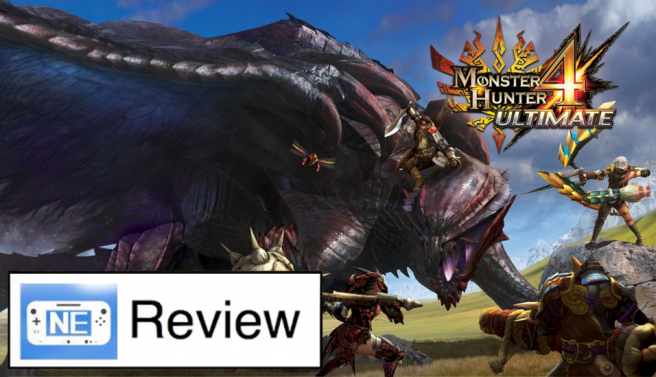[Review] Monster Hunter 4 Ultimate (3DS)
Posted on February 12, 2015 by Austin(@NE_Austin) in Features, Reviews
“Of course, I thanked my friend. Manners are the finest dessert, as we in Yukuko say.”
System: Nintendo 3DS
Release Date: February 13th, 2015
Developer: Capcom
Publisher: Capcom
Author: Austin
Monster Hunter, from outside the cult of its supporters, looks awfully intimidating doesn’t it? Just the phrases that come to mind when people bring it up– “gear grind”, “brutally difficult”, “extremely inaccessible”, “clunky”, “time sink”– don’t exactly do the series any favors in the eyes of newcomers, so it hardly comes as a revelation that the appeal of its extremely nuanced and strategic real-time combat system has remained limited outside of Japan. Something about that country seems to give them a higher tolerance for this sort of thing.
Nevertheless, Capcom seems to be enchanted with the idea of Monster Hunter’s ubiquity in the west, and so we’ve arrived on the doorstep of Monster Hunter 4’s release on 3DS.
\\\
Perhaps the most important thing to understand about Monster Hunter 4 up front is that it exists unapologetically; it’s easy to feel some sort of fundamental inspiration driving all of this game’s decisions. From the clunky (though, the word “nuanced” truly does fit it more appropriately) controls in combat to the feline-laced aesthetic, this game knows what it wants to be and it does not sully itself with watered-down mechanics or simplify itself for the sake of more instant appeal. It’s not for everyone, and it doesn’t try to be.
That being said: Monster Hunter 4 Ultimate is easily as approachable as this idea has ever been.

Your first plunge into monster hunting will amount to choosing a weapon class (“Great Sword”, “Hunting Horn”, “Sword & Shield”, etc), getting a set of armor, embarking a quest, and then promptly getting extremely frustrated that you don’t seem to be as immediately maneuverable as you might like to be. It feels a bit like how I imagine operating a Gundam might; until you’ve done it enough, there’s a disconnect between your inputs and how the Gundam maneuvers.
Perhaps a better comparison is learning to drive a car though.
As a question of practicality, this is the moment that will separate those who will enjoy Monster Hunter from those who won’t. As a question of what Monster Hunter is trying to give to the player, this is where things get very interesting.
The game has controls that make a very slow and deliberate first impression. You’ll quickly come to realize that more or less no matter what class you’ve chosen, doing the most basic of attack moves is… well, it’s not particularly basic. This is fine, for now, as the quests you’re doing towards the beginning of the game really don’t require very much of you, and missing more often than not really won’t be of any consequence when you’re supposed to be gathering mushrooms. They aren’t going to fight back, and gigantic swords have never been the ideal tool for mushroom harvesting anyway.

You spend the first hours (yes, hours) of the game gathering mushrooms, fishing, maybe knocking a few smaller enemies about, and generally getting used to the movement and camera controls. This is a 3DS, after all, and if you’re not playing with an Circle Pad Pro or one of those fancy New 3DS models, you can imagine that the camera controls take a good bit of “getting used to” in a game like this. They do, though the game does a pretty good job supplementing things with a virtual d-pad on the touch screen that you can swing the camera around with. It’s not ideal, but once you’ve wrapped your fingers around it the annoyances more or less fall by the wayside after five or six hours, with a few exceptions, one of which is called the “Tetsucabra”.
Obviously it doesn’t sound particularly fun in its own right to spend the game’s early hours doing very little of substance beyond learning to gather mushrooms, mix potions, craft armor, control the camera, and other such tutorial tasks, but Monster Hunter 4’s goals hinge upon you learning these skills at some point. And thus, the key question: What can the game do to prevent us from throwing the cartridge down a food processor during this portion? As it turns out, quite a bit.
Firstly, it uses all of the standard tricks of the trade for turning boredom into benefit: The game has a great sense of aesthetic “self” with appropriate music and very visually enjoyable environments, and the dialogue remains so consistent with the surrounding context that it feels as though they’ve had an entire series of games to nail down how this fictional universe works.
Oh. Have they?
Nevertheless, the blood-red cliffs of the Ancestral Steppe (your first hunting ground) that give way to auburn forests and desolate mountain-tops have an enchanting effect, and the attention the game pays to sound design helps endow these areas with some real life that– for reference– has been oft-missed in previous entries.
NPCs using monster names in analogies (“You’ve got some Durambaros-sized stones”, etc) is a nice touch as well, even if it gets a bit cheesey.

But the most important thing they’ve done to make this learning portion more than tolerable is to build a sense of anticipation right from the start. The very first thing you do after creating your character is to jump on the back of a gargantuan sand-whale from the plank of a sand-boat while cruising at high speeds through a desert to retrieve your sand-captain’s pirate hat that he lost when the aforementioned sand-whale attacked your sand-boat. (deep breath)
Not only is it visually exciting– which is a great step to getting people invested in your world initially– but it sets up the perfect context for anticipation to grow. Immediately you know exactly what this game is going to give you: You are David, and Monster Hunter 4 is Goliath. The level of excitement this game has now showed you it will reach is what will drive you to learn.
Thus, the first several hours of gathering mushrooms and doing relatively menial tasks are brimming with anticipation and anxiety over when you’re going to get to the good part. Rather than feeling plodding, it feels tense, and all it took was a few minutes of a good first impression at the beginning of the game. The game follows through adequately as well; the story is hardly incredible, but characters are generally written with chuckles in mind and the singleplayer experience has enough little gameplay wrinkles and locale chages to mask the fact that, really, you’re just selecting quests from a board.
This, if you’re curious, is the game’s most substantial change from the previous title in the series, Monster Hunter 3 Ultimate. Capcom has managed to figure out an accessible and effective way of presenting this very inaccessible and ambitious gameplay concept without actually compromising the core mechanics, and that makes for an incredibly impressive experience.

The actual process of choosing, tracking, and fighting monsters through the game’s environments is really the most incredible thing about Monster Hunter 4 though. Setting aside the wonderful art of monster designs, the game must be admired for its attention to creating foes that not only look, but act differently enough to actually require strategic changes from fight to fight. Unless you’ve got disproportionately powerful equipment (which really doesn’t happen unless you’re going down to lower ranks of monsters for something), it’s likely that for the first few minutes of fighting any new monster, you’re going to get hit a lot as you learn its danger zones.
As an example: There’s a fellow called the “Lagombi” in this game– a sort of hybrid rabbit-beat-Hagrid… thing– whose attacks range from sliding at you on his belly, to throwing balls of ice at you, to doing a sort of break-dance spin on the ground to knock you back. Most of his attacks are forward-reaching, which means you learn pretty quickly to attack from the back or sides, but the inclusion of this breakdance attack– which has a 360 degree range of damage and knockback– means you can’t just attack from the back. Ideally, you’ll attack from the back or sides while constantly monitoring his movements and keeping your finger right next to that block or dodge button.
The battle dynamics change based on the speed of monsters, what angles they can attack from, whether they fly or stay on the ground, whether they can dig or leap– there are so many variations without even considering the predictive element of trying to read each monster’s “tells” (a la Mike Tyson’s Punch Out!!) that going in strategically blind will surely get you in a lot of trouble.
Supplementing this is how varied the individual arenas within a given map are. Both in relation to previous entries (compared to which the contrast is even more obvious) and in absolute terms, the introduction of verticality has proven to be a very fruitful design choice for Monster Hunter 4 because it allows the game to add a new wrinkle of pacing to battles that were already incredibly varied to begin with. Now your location in an arena and the design of the arena accounts for a lot of your strategizing as you attempt to leverage a height advantage or prevent the monster from leveraging a height advantage against you. The thoughtfulness is further multiplied.
You can imagine how this transitions into multiplayer as well: It’s not every single case that the strategy is multiplied four-fold (the limit on multiplayer co-op), but in the multiplayer mode monsters are tougher and there’s no story to slow things down, so the enjoyment comes entirely from four people all having to trust one another’s mastery of their weapon class and their thoughtfulness in preparation to stay alive. The riotous laughter or riotous rioting that can result from losing a quest or just barely scraping by with a win against a huge enemy is sometimes enough to convince you that this is really what Capcom had in mind when designing this game, even if they did do a tremendous job with solo play as well.

Strung around this unique, thoughtful, and steadfast gameplay core is a whole lot of bric-a-brac to partake in. Hundreds of quests, pieces of armor, weapons, items, modes, and monsters certainly give this RPG-liketreadmill plenty of flourish, even if the core gameplay is about as far from a turn-based RPG as you might be able to get. You get new weapons and armor by gathering materials and bringing them to a blacksmith to have put together, and you can guarantee that the shiny, beautiful Tetusacabra armor you see there is going to take a heck of a lot more time and effort to make than the fantasy-basic chainmail. It’s time consuming and addicting, but it’s seriously satisfying to get ahold of a set of armor you’ve wanted for a while.
Also worth noting is just how smart the game is about continuing to teach you about all of these systems as the game goes on. It’s a lot to take in– how to combine things, craft armor, how to use traps and bombs and other things– and giving it to you outright in text-form really wouldn’t be of much fun. Instead, you’ve got NPCs whose dialogue is almost always laced with a hunting tip of some kind– “How are you hunter? The last time I hunted with my friends, one of them used a voucher! You see, a voucher covers a meal for all hunters present when playing multiplayer!”– and a “HELP” icon in the upper left of every menu screen that you can always push to get relevant information. They don’t force these things on you, but they don’t hesitate to remind you that they are there.
The effect of this is kind of astounding. By the time you get into the meat of the game (ten or fifteen hours) you’ll start to be sort of bewildered at where you learned all of this information. It feels like you did pretty minimal reading and not nearly enough tutorials to cover what you know, and yet, you know it. The game is a pretty ingenious teacher in that regard, serving information to you piecemeal, constantly, for hours, rather than all at once at forced points.
I cannot stress enough: If you succeed in Monster Hunter 4, it’s your fault, and if you lose in Monster Hunter 4, it’s your fault. It has no nonsensical fudging around with automatic combat corrections, sticky platforming, myriad free items if you forgot them– none of that. And that’s really why Monster Hunter 4 succeeds in the end: Its core appeal is one based around accountability rather than undisturbed fun and the entire design is built to exaggerate the highs and lows of that. As a result, the experience isn’t steady– sometimes it’s boring or frustrating, no doubt– but when it’s fun, it’s a much more thrilling sort of fun than you’d get if the game was less dynamic. It’s not a trade-off everyone will be willing to make, but you can’t deny that Monster Hunter 4 is in a masterclass of few games that confidently commit themselves to a unique idea and cut no corners for the sake of simplifying the experience for a wider audience.
It’s an idea that could have easily lead to another “flawed gem” of a game. Instead, it’s just a gem.

Regardless of whether you’ve played a Monster Hunter title before or not, Monster Hunter 4 will stand out to you. For series veterans, the improvements made to this entry only make the game more enjoyable and they don’t encroach at all upon the fascinating, inaccessible combat or gear-grinding system. For newcomers? This is easily the best translation of Monster Hunter‘s eccentricities that you’ll find; it’s not any less complicated than it was before, but the way it presents itself makes you much more confident that you can figure it out without needing a tour guide, online FAQ, or hours of frustrating trial and error.
If you know nothing of Monster Hunter but want the quick and dirty about whether you should buy it, here’s my pitch: It’s an experience entirely built around a non-traditional style of control that will inevitably frustrate at first attempt, but if you have a pinch of patience and enjoy incredibly dynamic and utterly thrilling experiences– particularly with friends– you’ll find nothing but near-perfection in this game. It’s one of those rare cases where someone executes a unique and pretty intimidating idea with real finesse.
Want to participate in more NintendoEverything goodness?
Try our Facebook page!
Or our Twitter page!
